A box I’m building has a flush fit lid. Holding the lid in temporary positions for various marking and fitting operations needed some temporary “posts” to prop it at the right heights. How to prop it up? Wood? Sure, why not? I cut lots of wood.
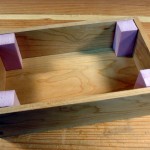 However, is there something that can be shaped faster? Oh yeah. A package that arrived a few months ago used Owens Corning “Pink Panther” foam insulation as padding.
However, is there something that can be shaped faster? Oh yeah. A package that arrived a few months ago used Owens Corning “Pink Panther” foam insulation as padding.
Perfect. It’s about an inch thick and easy to cut with a knife. Pink posts standing in the corners did the job nicely, and are quickly cut to new heights for final fitting.
Ponce on that!
Transferring carving patterns to the work piece is a challenge. Carbon paper used to be the normal process. Today, the stuff is becoming incredibly rare and expensive. Staple’s smallest package is 100 sheets for $16. I only need a few sheets, not 100. Beyond that, it’s also much drier than the old messy stuff we had long ago and does a really poor job of transferring.
Mary May offered a helpful tip in her latest newsletter, but it uses laser printer output, more modern than carbon paper but not as popular as ink-jet printers.
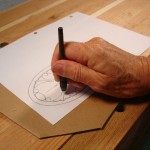 Dad, in his sign painting days, used paper patterns riddled with tiny holes and a ponce bag to force colored chalk through the holes. You might have to go to both a fabric store and an art supplies store to get a ponce bag and the tool to make the holes (ponce wheel). Looking around, I found enough stuff already on hand to make my own tools.
Dad, in his sign painting days, used paper patterns riddled with tiny holes and a ponce bag to force colored chalk through the holes. You might have to go to both a fabric store and an art supplies store to get a ponce bag and the tool to make the holes (ponce wheel). Looking around, I found enough stuff already on hand to make my own tools.
Hole making: they’re just pin holes, use a pin. Chuck it in a pin vise (on hand from times when I made models) and go to it. 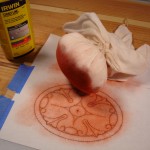 Hint: put a piece of corrugated cardboard under the pattern.
Hint: put a piece of corrugated cardboard under the pattern.
Ponce pad: they’re simply fabric bags full of chalk. An old handkerchief, some chalk used for striking lines (hello carpenters), and a bit of string is all one needs.
It works! For simple patterns, the chalk marks are enough, and last long enough to do the carving. 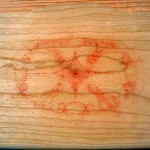 For more complex patterns, I go over the design with a pencil.
For more complex patterns, I go over the design with a pencil.
Last hint: Keep your patterns and pattern making tools all on one place so you won’t have to play this song when you need a pattern again.
Not a box
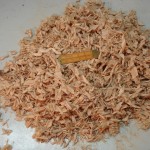 I sweep the shop floor once in a while. These are the shavings and dust that come from resawing and shaping the wood for the current box. I enjoy doing it all with handtools, and enjoy even more having outlaw country or soft jazz replace the noise of whining tools and dust collectors. Besides, these shavings have many more interesting shapes than the dust in those cyclone bags.
I sweep the shop floor once in a while. These are the shavings and dust that come from resawing and shaping the wood for the current box. I enjoy doing it all with handtools, and enjoy even more having outlaw country or soft jazz replace the noise of whining tools and dust collectors. Besides, these shavings have many more interesting shapes than the dust in those cyclone bags.
I definitely related to your closing comments, as the ability to listen to music in the quiet of a hand-tool shop is one of the reasons I have moved so strongly in that direction. Today I listened to some bootleg Los Lobos, Eva Cassidy, and Diana Krall while working. I don’t need to have audiophile quality of sound, but it is nice to hear the music without it being at ear-splitting volume.
Hear here Don!!!
Eva and Diana are frequent friends in my shop. Gonna have to try those wolves.